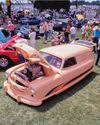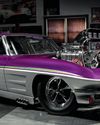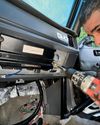
Manufacturers of modern V8 engines have realized that we don't always need all eight cylinders all the time, and that's why cylinder-deactivation technology has been incorporated into many newer cars. If the vehicle is cruising along with a low-torque output, there are plenty of cases where half the engine would be enough to get the job done. After all, plenty of four- and six-cylinder cars are also capable of cruising along at the same speeds on the same roads, right? The whole reason we have the "extra" cylinders is to satisfy our need for on-demand power whenever we mash the accelerator. Admittedly, this is only a fraction of the time the engine is running, so being able to dial torque back to something that mimics a smaller engine when loads are light can have very real advantages in both fuel economy and emissions.
Here's how the process works: With no fresh-air charge entering the cylinder, the fuel injector can also be shut off. The remaining cylinders must pick up the slack to deliver the total amount of torque needed by the engine, but they get more efficient during this process. When feeding all cylinders, we control the airflow with the throttle body, and must restrict this airflow to avoid making too much torque at any moment during light loads. This restriction comes with a loss in overall pumping efficiency for the engine. When shutting off some of the cylinders, it becomes necessary to increase the relative flow to the remaining cylinders, which is accomplished by opening the throttle slightly and increasing the intake manifold absolute pressure (MAP) as well. Not needing to draw as much vacuum across the throttle blade is the mechanism that frees up some of the pumping losses and, thus, improves fuel economy.
This story is from the January 2024 edition of Hot Rod.
Start your 7-day Magzter GOLD free trial to access thousands of curated premium stories, and 9,000+ magazines and newspapers.
Already a subscriber ? Sign In
This story is from the January 2024 edition of Hot Rod.
Start your 7-day Magzter GOLD free trial to access thousands of curated premium stories, and 9,000+ magazines and newspapers.
Already a subscriber? Sign In

What Is Pro Street?
You know it when you see it.

Pro Street in Pure Vision
Builder Steve Strope weighs in on the Pro Street look and what he would build today.

THE GAS ERA LIVES ON
These vintage race cars chart the evolution of technology in the early days of drag racing.

MOTOR HEAD FOR LIFE
Scott Sullivan is one of the original Pro Street pioneers. He still builds cars today out of a small shop in Dayton, Ohio.

BRINGING BACK PRO STREET!
David Freiburger and Roadkill Garage built a Pro Street Nova.

SWEET ASPIRATIONS
Jerry and Matthew Sweet added an 800ci Pro Stock mountain motor to chase HOT ROD Drag Week's Pro Street NA Record.

Making Bad Decisions Badder
Bradley Gray's 1970 Nova is a Hybrid! It's a streetable Funny Car.

ART PROJECT
This Rad Rides by Troy-built '63 split-window Corvette went from restaurant prop to ripping up the street!

WHERE DO WE GO FROM HERE?
THE PRO STREET ERA PEAKED IN THE '80S. ARE WE IN THE BEGINNING OF A RESURGENCE?

Making Connections
Project T-top Coupe: We install a Terminator X Max for big power.